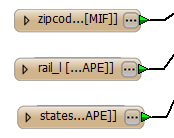
You can add one reader, or specify multiple datasets to include as multiple readers.
If you drag the file directly onto the Workbench canvas, the Add Reader dialog box will appear with the format and dataset name already filled in.

Workflow options determine the number of feature types that will be displayed on the canvas. Selecting either one will not affect the outcome of the workspace: these options determine only how the feature types appear on the canvas, and how they are interpreted within the workspace.
By default, the Individual Feature Types option will be selected. This means that for every feature type in the dataset (assuming there is more than one), Workbench will display a corresponding feature type on the canvas. This has always been the default workflow for Workbench and for most workspaces, this option is sufficient.

If, however, you want to display only one feature type on the canvas, you can select Single Merged Feature Type. All feature types in the source dataset are merged into one single feature type.

Note: If you want to separate the feature types later, you can do this through the Feature Type Properties dialog.
After you press OK, the log window will display processing information, and the feature types will appear in the reader area of your workspace.
To extend the input of your workspace to include multiple source datasets that are in a different format than your existing source dataset:
 . Type directly in the Directory field (you can use wildcards
to include all files of a specific format), or click Add Folder button
to browse for a specific directory name. Click the Subfolders box to also
include all subfolders below that directory. If you know that files are
the same schema, check the Identical Schemas box (this can have an effect
on overall processing time if you have many datasets).
. Type directly in the Directory field (you can use wildcards
to include all files of a specific format), or click Add Folder button
to browse for a specific directory name. Click the Subfolders box to also
include all subfolders below that directory. If you know that files are
the same schema, check the Identical Schemas box (this can have an effect
on overall processing time if you have many datasets).